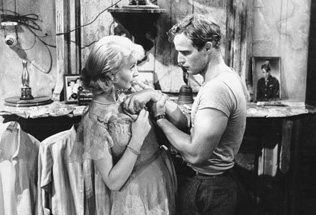|
|
AFInity: A Streetcar Named DesireBy Kim HollisJuly 17, 2009
It is this dynamic that provides the backbone for A Streetcar Named Desire. Although Blanche presents herself as a woman of society and virtue, the audience infers immediately that she has dark and shameful secrets. The story is not overly complex. Blanche, claiming to have been allowed to take time off from her teaching position due to exhausted nerves, comes from her antebellum hometown of Auriol, Mississippi to visit her sister, Stella, in New Orleans. Stella is pregnant and married to the rough-cut, violent-tempered Stanley Kowalski, and he seems to take an instant dislike to his sister-in-law to the point that he sets out to uncover what he believes are a series of lies that she has told to explain her situation. He even sabotages her budding relationship with a friend of his, though that isn't even close to being the worst thing he'll do to her in the course of the film. It doesn't sound like such a plot would provide much heft, yet the film works well on a number of levels. Key amongst these is the fact that A Streetcar Named Desire is a dynamic character study focusing on two individuals who exist on opposite ends of the spectrum. Blanche, with all her glittery refinement, fading beauty and recent fall from high society to madness and disgrace, mirrors the decline and change that was occurring in the deep South during Williams' lifetime. Stanley, who is deeply sexual, unrefined, brutish and dominating, can be seen as the new immigrant class that was coming to dominate America. Whereas Blanche prefers illusion and idealism (she even covers the lamp in the living room so as to disguise her appearance), Stanley is all truth and realism, even though that truth might be something ugly and difficult to face.
|

|
|
|

|
Thursday, October 31, 2024
© 2024 Box Office Prophets, a division of One Of Us, Inc.


